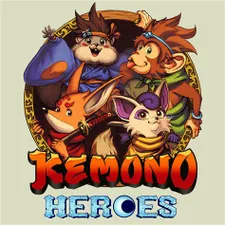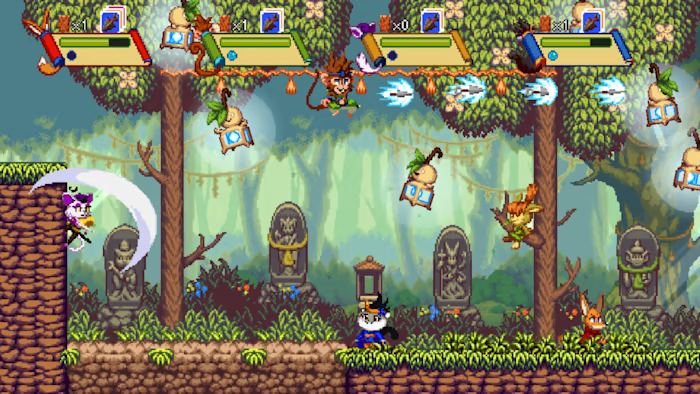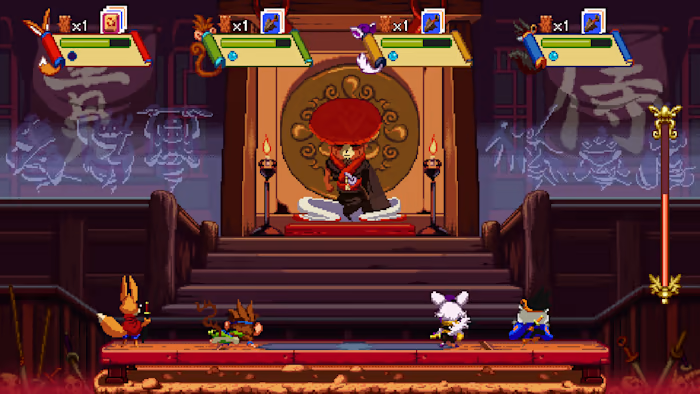Search
[{{{type}}}] {{{reason}}}
{{/data.error.root_cause}}{{{_source.title}}} {{#_source.showPrice}} {{{_source.displayPrice}}} {{/_source.showPrice}}
{{#_source.showLink}} {{/_source.showLink}} {{#_source.showDate}}{{{_source.displayDate}}}
{{/_source.showDate}}{{{_source.description}}}
{{#_source.additionalInfo}}{{#_source.additionalFields}} {{#title}} {{{label}}}: {{{title}}} {{/title}} {{/_source.additionalFields}}
{{/_source.additionalInfo}}- Details
- Category: Switch
- By Michael Ross
- Hits: 1727
Kemono Heroes (Switch)

Kemono Heroes
Released: February 27, 2020
ESRB Rating: E (Mild Fantasy Violence)
Available On: Nintendo Switch
Genre: Action Adventure / Platformer
Number of Players: 4 (local co-op)
Price: $14.99
Kemono Heroes is a rather obscure action-adventure platformer that harkens back to the early 16-bit era of games with its gameplay and visuals. You run and jump through levels, avoid obstacles, destroy enemies, pick-up items, and fight a boss at the end of each world/zone. Like the games from the era it takes inspiration from, the content of this game is essentially just the game itself.
The story of Kemono Heroes takes place in a fantasy setting resembling feudal Japan but populated with animal folk. The Moon God (whoever he is) has unleashed his wrath upon the world (for reasons unknown) and is turning its inhabitants to stone. It's up to the four animal ninja masters (well, "ninja") to fight their way across yokai-infested lands to stop the Moon God and reverse his spell. This is about as much context as you'll get, as Kemono Heroes completely forgoes the use of text and instead relies on level elements and in-game cutscenes to tell its story. Its also chock-full of references to Japanese culture. Its enemies and bosses are based on creatures from Japanese mythology and folklore, while its locale, background, items and NPCs seem to take inspiration from feudal Japan.
The main feature that sets Kemono Heroes apart is that it has 4-player local co-op, but for the purposes of this review I will be writing under the assumption of the game being played single-player, as multiplayer changes the experience enough that it needs to be addressed in its own section.
You have four playable characters to choose from: Fudemaru the fox, Miyuki, the cat, Hanako the flying squirrel, and Yu the monkey. Each character shares the same basic moveset. They all have a three-hit combo sword, infinite throwable kunai, a limited use screen-nuke item, and the ability to dash-kick, double-jump, and perform a downwards dash-kick in midair. As you progress you'll unlock a grappling hook, infinite throwable bombs, and the ability to charge your sword for a powerful ranged attack. What sets each character apart is their special ability: The fox can transform into enemies, the cat can climb walls, the squirrel can glide, and the monkey can climb ropes. In addition, each character fights differently with their sword, covering different ranges and areas around themselves. While at first glance these aren't huge differences, it's enough to change how you approach combat and level traversal.
You get to pick your character and difficulty setting (Easy, Normal, or Hard) when starting a New Game. Once the game is started, you'll be stuck with that character and difficulty setting for the rest of that save, requiring you to start a New Game to play as a different character or pick a difficulty. No explanation is provided for the differences between the characters, nor for the differences between the difficulty settings. In fact, this principle applies to pretty much everything else. There is no manual and no in-game reference for the controls, meaning you have to figure out what your character can do on your own. Without the eShop page you probably wouldn't have known what each characters' special ability was in the first place until you stumbled upon it by accident. The controls are fairly simple so it's not a huge problem, but the lack of explanation made things a bit confusing at first. However, it does have the sense to explain how to use a new item once you obtain it.

Strong Points: Colorful pixel graphics with appealing art and character design; good music that sets the mood; movement options that allow for fluid and fast level traversal; simple but solid combat
Weak Points: Can be beaten in roughly an hour on a normal playthrough; multiplayer makes the game more tedious on Normal difficulty; game makes you go through the same levels twice in a single playthrough
Moral Warnings: Violence against mythical creatures (no blood); ghosts and spirits as enemies; enemies release spirits upon dying; characters stated or implied to use magic; references to Shinto deities and religious practices; you're implied to play as the disembodied souls of your character(s) in the second half of the game; characters temporarily become ghosts when having lost all of their lives
The game is divided into worlds and levels, totaling to about 4 worlds and 3 levels per world. In each level your goal is to get to the end by overcoming platforming challenges and obstacles while fighting your way through the numerous enemies that block your path. Each world has a general theme, and sometimes levels will shake things up a bit mechanically speaking. One level makes you periodically take cover to avoid giant energy blasts from the Moon, while another one has you flying through the skies in an autoscroller. Each world also has its own enemies and its own boss at the end (and sometimes one in the middle), though enemies from previous levels will sometimes appear in later levels. Killing enemies or destroying chests will usually drop money and health pickups, and occasionally screen-nuke refills and extra lives. The money you collect can be used at a shop at the end of levels to upgrade your character's abilities. You can upgrade the strength of their weapons, their total health, and the number of screen-nukes they can carry at once. You can also replenish your health, screen-nukes, and lives. In this sense Kemono Heroes rewards skillful play as the less money you spend on health, lives and screen nukes, the more you can spend on upgrading your character's abilities.
The controls themselves are really tight and allows for surprising freedom of movement. Jumping while dashing allows you to perform a dash-jump similar to the Mega Man X series, giving you the speed of the dash with the mobility of midair movement. Your "downwards midair dash-kick" allows you to bounce off of enemies, and this technique retains the momentum of your dash jump while also refreshing your double jump. The momentum of your dash is also preserved while using the grappling hook and while using Hanako, Miyuki, and Yu's character abilities (Fudemaru doesn't get a movement ability, but some of his enemy transformations can make up for this). Proper use of these techniques allow you to traverse levels at high speeds, which can be really fun.
The combat is simple but also fun. Your melee doesn't go past a simple three-hit combo, but you're able to use this combo mid-air and while climbing/gliding (for the characters who can climb/glide). Your ranged options consist of kunai, which are able to be thrown in eight directions, and bombs. The dash and grappling hook also deal a small amount of damage, though they're primarily used for movement. You’re never forced to use a screen nuke, but they can be useful if you end up overwhelmed by enemies. Enemies are similarly simple, having only one or two attacks each. This also goes for the first few bosses, but the later bosses have more complex attack patterns.
I found playing on Normal difficulty to be fairly forgiving, while still providing enough of a challenge to be fun. I didn’t have to fully upgrade my character to beat the game, though it did help that my sword and kunai were at max level by the final levels. The game was also more fun on my second playthrough, as by then I was more familiar with the movement and was able to blast through levels feeling like a true ninja hero (well, “ninja”).
Gameplay seems geared towards getting through a level in a timely manner. There's no time limit, but some spots have difficult enemy placement or constant enemy spawning that makes sticking around for too long a bit hazardous for your health. You could linger to farm enemies for money, but I never found this necessary. I was able to keep a steady pace through most levels and was still able to upgrade my character enough to handle most threats smoothly. Plus, the game specifically prevents you from maxing out your stats too early, meaning you can only reach max level in a stat once you reach a certain point in the game.

Higher is better
(10/10 is perfect)
Game Score - 78%
Gameplay - 14/20
Graphics - 9/10
Sound - 8/10
Stability - 4/5
Controls - 4/5
Morality Score - 80%
Violence - 6.5/10
Language - 10/10
Sexual Content - 10/10
Occult/Supernatural - 3.5/10
Cultural/Moral/Ethical - 10/10
Aside from its lack of documentation, Kemono Heroes' biggest flaws are its length and possibly its multiplayer. Once I got the movement down I was able to beat it from beginning-to-end in under 80 minutes on Normal difficulty. It does have replayability in that it has four characters, three difficulties, achievements, and a de-facto New Game+ mode that retains your upgrades from the previous run. But once you play all four characters, you pretty much experience most of what this game has to offer within a relatively short amount of time.
It's also worth mentioning that you actually go through the same four worlds twice in a normal playthrough. While the levels have some alterations that make them more difficult and have some significant visual and audio changes, they're still the same layouts and locations. You also fight harder versions the same bosses at roughly the same intervals. Overall this could run the risk of becoming repetitive on multiple playthroughs.
The other biggest flaw is ironically one of Kemono Heroes’ selling points: the multiplayer. It was a great idea, but issues in its execution dampened the overall experience. The health of enemies, bosses and hazards seems to increase to compensate for the larger number of players, but this ended up turning the game into a slog due to enemies and bosses taking much longer to defeat on average. Additionally, the characters all share the same camera, so a character lagging behind causes the camera to lag behind, causing those in front to get hit by enemies they couldn't see a moment ago. The camera also can't move backwards, meaning a player in the back can get stuck in a difficult situation and backtracking won't give them any more breathing room to work with. And while this situation isn't particularly unique to Kemono Heroes, having more than two players on the screen at once led to moments of confusion. This resulted in an experience where we felt that the damage we took was unfair and we were only able to succeed because we had health and lives to burn. (Note that our experience was playing on Normal difficulty with three players. These problems may not be so egregious if played on Easy or with just two players. Also, Kemono Heroes allows players to revive each other and donate lives, which helped make the difficulties experienced a little less punishing overall).
Kemono Heroes does has some strong points though. When I played through on my own, I found the core gameplay to be very enjoyable in spite of its length. Kemono Heroes also has some very charming visuals. The characters are fairly expressive and well-designed, and the environments are colorful and detailed. The level design also felt pretty organic and matched the environments they took place in. The music is also really good, usually setting the mood very well, though the OST isn't quite to the level of being an outright earworm (though the theme for the first level is still stuck in my head as I write this). Sound design is also pretty good, though nothing stands out as particularly memorable. I've only encountered one or two brief audio or visual glitches that had no impact on gameplay, so overall I'd say this game is pretty stable.
Any moral concerns in this game would mostly be to do with the supernatural. The game takes heavy inspiration from Japanese folklore, with the enemies, bosses and one of the main characters being based off of yokai. These yokai range from the likes of mythical creatures to ghosts and spirits. For example, you fight a tengu as your first boss, and the second world takes place in a ghost town where spirits possess furniture to attack you with. There's also inspiration taken from Japanese religion, with shrines and priestesses being present (mostly as background elements), as well as deities (Fujin and Raijin, for example, are the boss of World 3). The screen-nuke items are described as "Ninpo Magic", albeit there's nothing very overtly magical about them. Fudemaru throws what appears to be a paper ofuda at enemies in order to take their form. Enemies seem to release a ghost/spirit when they die.
During the second half of the story, it’s implied that the characters died from petrification and that their disembodied spirits (seemingly revived with the aid of a priestess who may or may not also be a ghost, but it's not exactly made clear) have to fight their way through the previous levels in order to collect some MacGuffins and get back to their petrified bodies (it's possible that the altered visuals and audio of these repeat levels are meant to imply that they’re in the spirit realm or something, but this is mostly speculation as there’s no explanation provided).
The other moral concern would be the violence, as you use swords, throwing knives, and bombs to destroy enemies. While the damage you inflict is implied to be lethal force (since the creatures disappear with a ghost-like poof), there's no blood or gore and it's only inflicted on malicious mythical creatures.
Overall the game is a solid retro experience with satisfying core gameplay, albeit it may be a bit too faithful to its roots in its lack of quality-of-life features and overall short length. With its length being as short as it is your mileage may vary with the $14.99 price point, and if you're getting it with the intention of playing multiplayer you may want to try the Easy difficulty first. Morally if visual references to spirits, mythical creatures and non-Christian religious practices don't sit well with you then you might want to pass on this one. The violence is cartoonish in nature, so aside from the implication of lethality it's not much different from other games of its genre. That aside, if the game's visuals and cultural inspirations pique your interest and you're a fan of action-platforming with speedrunning potential, then I'd recommend giving this game a try.








